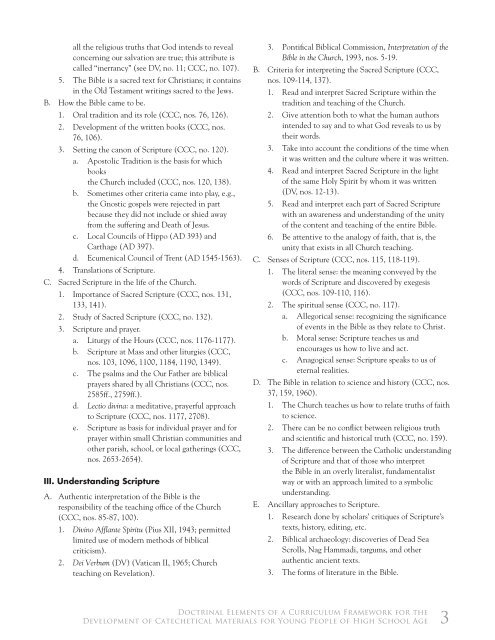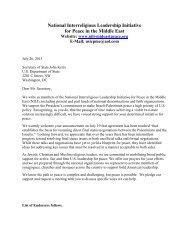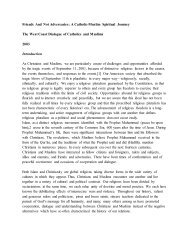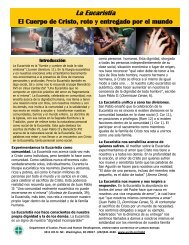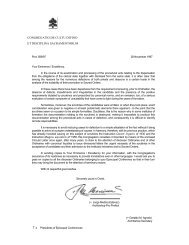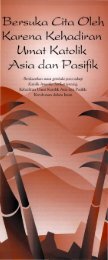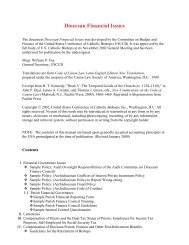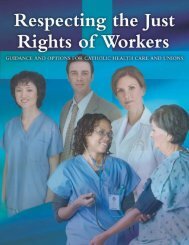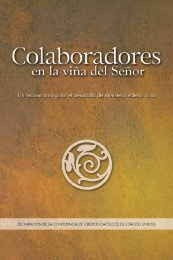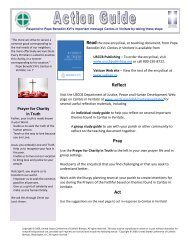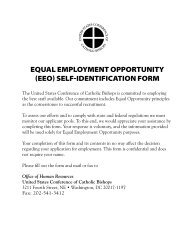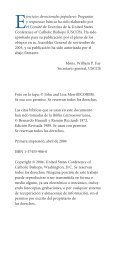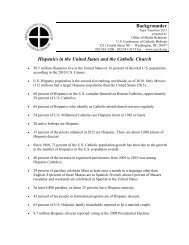Doctrinal Elements of a Curriculum Framework for the Development ...
Doctrinal Elements of a Curriculum Framework for the Development ...
Doctrinal Elements of a Curriculum Framework for the Development ...
- No tags were found...
Create successful ePaper yourself
Turn your PDF publications into a flip-book with our unique Google optimized e-Paper software.
all <strong>the</strong> religious truths that God intends to revealconcerning our salvation are true; this attribute iscalled “inerrancy” (see DV, no. 11; CCC, no. 107).5. The Bible is a sacred text <strong>for</strong> Christians; it containsin <strong>the</strong> Old Testament writings sacred to <strong>the</strong> Jews.B. How <strong>the</strong> Bible came to be.1. Oral tradition and its role (CCC, nos. 76, 126).2. <strong>Development</strong> <strong>of</strong> <strong>the</strong> written books (CCC, nos.76, 106).3. Setting <strong>the</strong> canon <strong>of</strong> Scripture (CCC, no. 120).a. Apostolic Tradition is <strong>the</strong> basis <strong>for</strong> whichbooks<strong>the</strong> Church included (CCC, nos. 120, 138).b. Sometimes o<strong>the</strong>r criteria came into play, e.g.,<strong>the</strong> Gnostic gospels were rejected in partbecause <strong>the</strong>y did not include or shied awayfrom <strong>the</strong> suffering and Death <strong>of</strong> Jesus.c. Local Councils <strong>of</strong> Hippo (AD 393) andCarthage (AD 397).d. Ecumenical Council <strong>of</strong> Trent (AD 1545-1563).4. Translations <strong>of</strong> Scripture.C. Sacred Scripture in <strong>the</strong> life <strong>of</strong> <strong>the</strong> Church.1. Importance <strong>of</strong> Sacred Scripture (CCC, nos. 131,133, 141).2. Study <strong>of</strong> Sacred Scripture (CCC, no. 132).3. Scripture and prayer.a. Liturgy <strong>of</strong> <strong>the</strong> Hours (CCC, nos. 1176-1177).b. Scripture at Mass and o<strong>the</strong>r liturgies (CCC,nos. 103, 1096, 1100, 1184, 1190, 1349).c. The psalms and <strong>the</strong> Our Fa<strong>the</strong>r are biblicalprayers shared by all Christians (CCC, nos.2585ff., 2759ff.).d. Lectio divina: a meditative, prayerful approachto Scripture (CCC, nos. 1177, 2708).e. Scripture as basis <strong>for</strong> individual prayer and <strong>for</strong>prayer within small Christian communities ando<strong>the</strong>r parish, school, or local ga<strong>the</strong>rings (CCC,nos. 2653-2654).III. Understanding ScriptureA. Au<strong>the</strong>ntic interpretation <strong>of</strong> <strong>the</strong> Bible is <strong>the</strong>responsibility <strong>of</strong> <strong>the</strong> teaching <strong>of</strong>fice <strong>of</strong> <strong>the</strong> Church(CCC, nos. 85-87, 100).1. Divino Afflante Spiritu (Pius XII, 1943; permittedlimited use <strong>of</strong> modern methods <strong>of</strong> biblicalcriticism).2. Dei Verbum (DV) (Vatican II, 1965; Churchteaching on Revelation).3. Pontifical Biblical Commission, Interpretation <strong>of</strong> <strong>the</strong>Bible in <strong>the</strong> Church, 1993, nos. 5-19.B. Criteria <strong>for</strong> interpreting <strong>the</strong> Sacred Scripture (CCC,nos. 109-114, 137).1. Read and interpret Sacred Scripture within <strong>the</strong>tradition and teaching <strong>of</strong> <strong>the</strong> Church.2. Give attention both to what <strong>the</strong> human authorsintended to say and to what God reveals to us by<strong>the</strong>ir words.3. Take into account <strong>the</strong> conditions <strong>of</strong> <strong>the</strong> time whenit was written and <strong>the</strong> culture where it was written.4. Read and interpret Sacred Scripture in <strong>the</strong> light<strong>of</strong> <strong>the</strong> same Holy Spirit by whom it was written(DV, nos. 12-13).5. Read and interpret each part <strong>of</strong> Sacred Scripturewith an awareness and understanding <strong>of</strong> <strong>the</strong> unity<strong>of</strong> <strong>the</strong> content and teaching <strong>of</strong> <strong>the</strong> entire Bible.6. Be attentive to <strong>the</strong> analogy <strong>of</strong> faith, that is, <strong>the</strong>unity that exists in all Church teaching.C. Senses <strong>of</strong> Scripture (CCC, nos. 115, 118-119).1. The literal sense: <strong>the</strong> meaning conveyed by <strong>the</strong>words <strong>of</strong> Scripture and discovered by exegesis(CCC, nos. 109-110, 116).2. The spiritual sense (CCC, no. 117).a. Allegorical sense: recognizing <strong>the</strong> significance<strong>of</strong> events in <strong>the</strong> Bible as <strong>the</strong>y relate to Christ.b. Moral sense: Scripture teaches us andencourages us how to live and act.c. Anagogical sense: Scripture speaks to us <strong>of</strong>eternal realities.D. The Bible in relation to science and history (CCC, nos.37, 159, 1960).1. The Church teaches us how to relate truths <strong>of</strong> faithto science.2. There can be no conflict between religious truthand scientific and historical truth (CCC, no. 159).3. The difference between <strong>the</strong> Catholic understanding<strong>of</strong> Scripture and that <strong>of</strong> those who interpret<strong>the</strong> Bible in an overly literalist, fundamentalistway or with an approach limited to a symbolicunderstanding.E. Ancillary approaches to Scripture.1. Research done by scholars’ critiques <strong>of</strong> Scripture’stexts, history, editing, etc.2. Biblical archaeology: discoveries <strong>of</strong> Dead SeaScrolls, Nag Hammadi, targums, and o<strong>the</strong>rau<strong>the</strong>ntic ancient texts.3. The <strong>for</strong>ms <strong>of</strong> literature in <strong>the</strong> Bible.<strong>Doctrinal</strong> <strong>Elements</strong> <strong>of</strong> a <strong>Curriculum</strong> <strong>Framework</strong> <strong>for</strong> <strong>the</strong><strong>Development</strong> <strong>of</strong> Catechetical Materials <strong>for</strong> Young People <strong>of</strong> High School Age3


